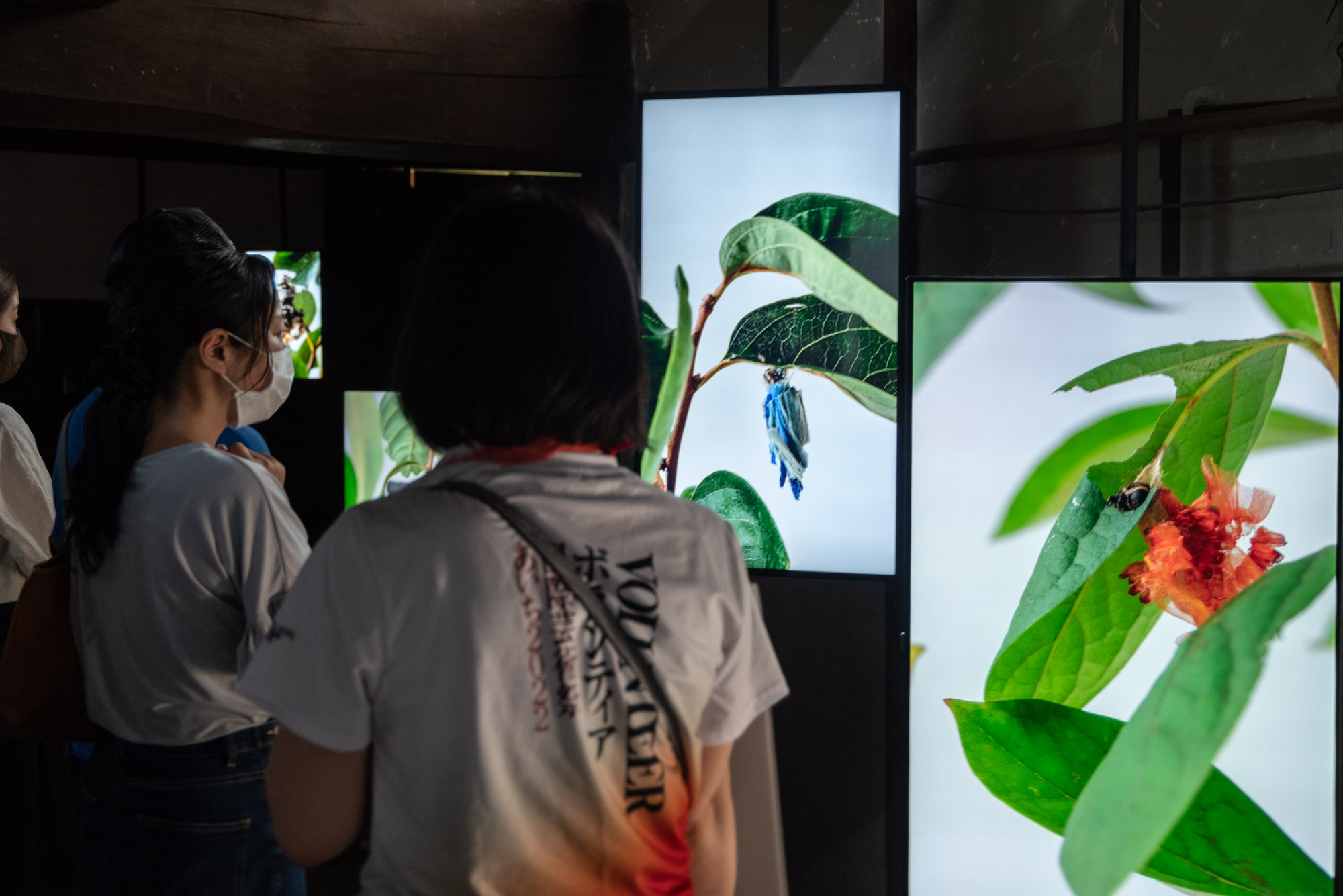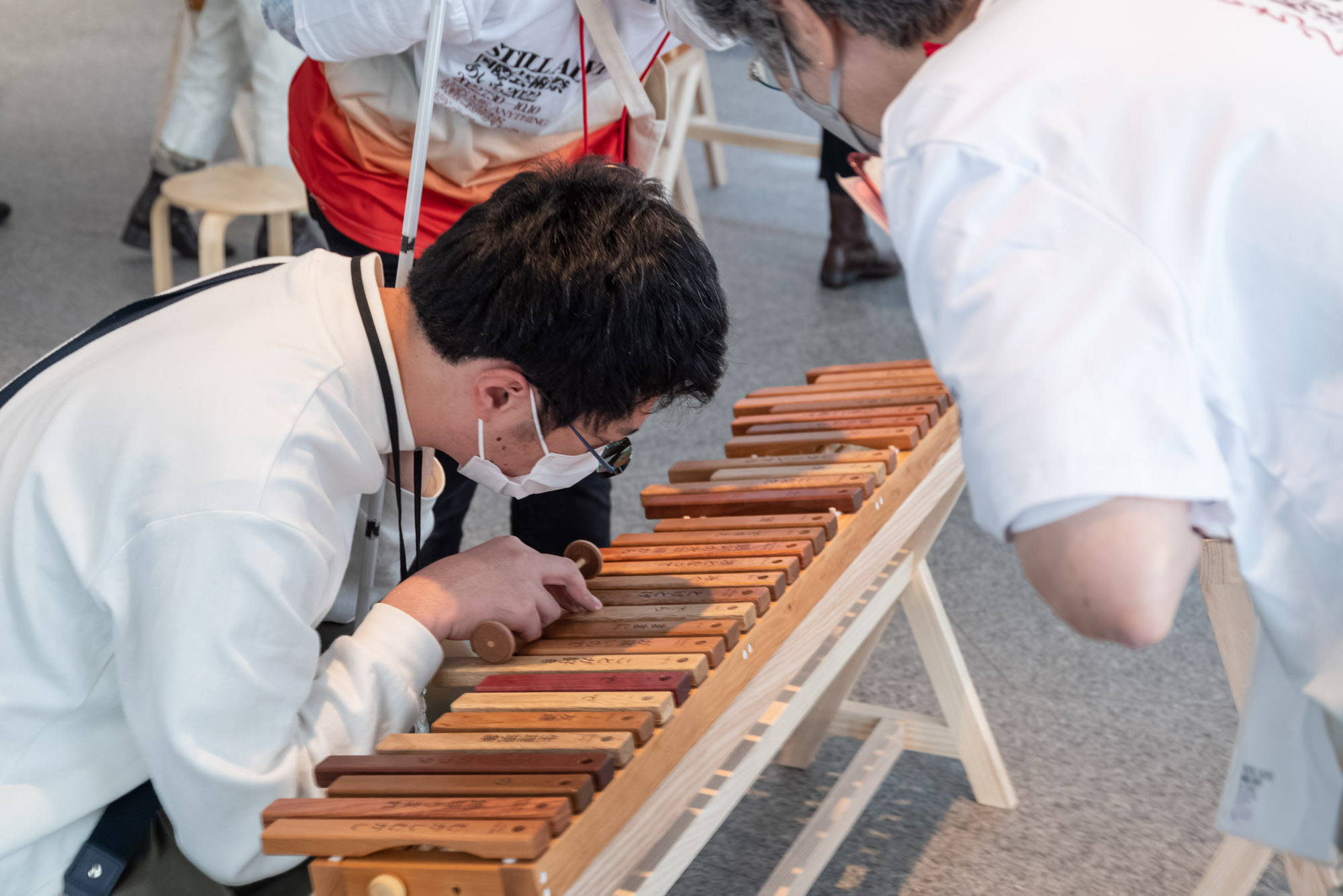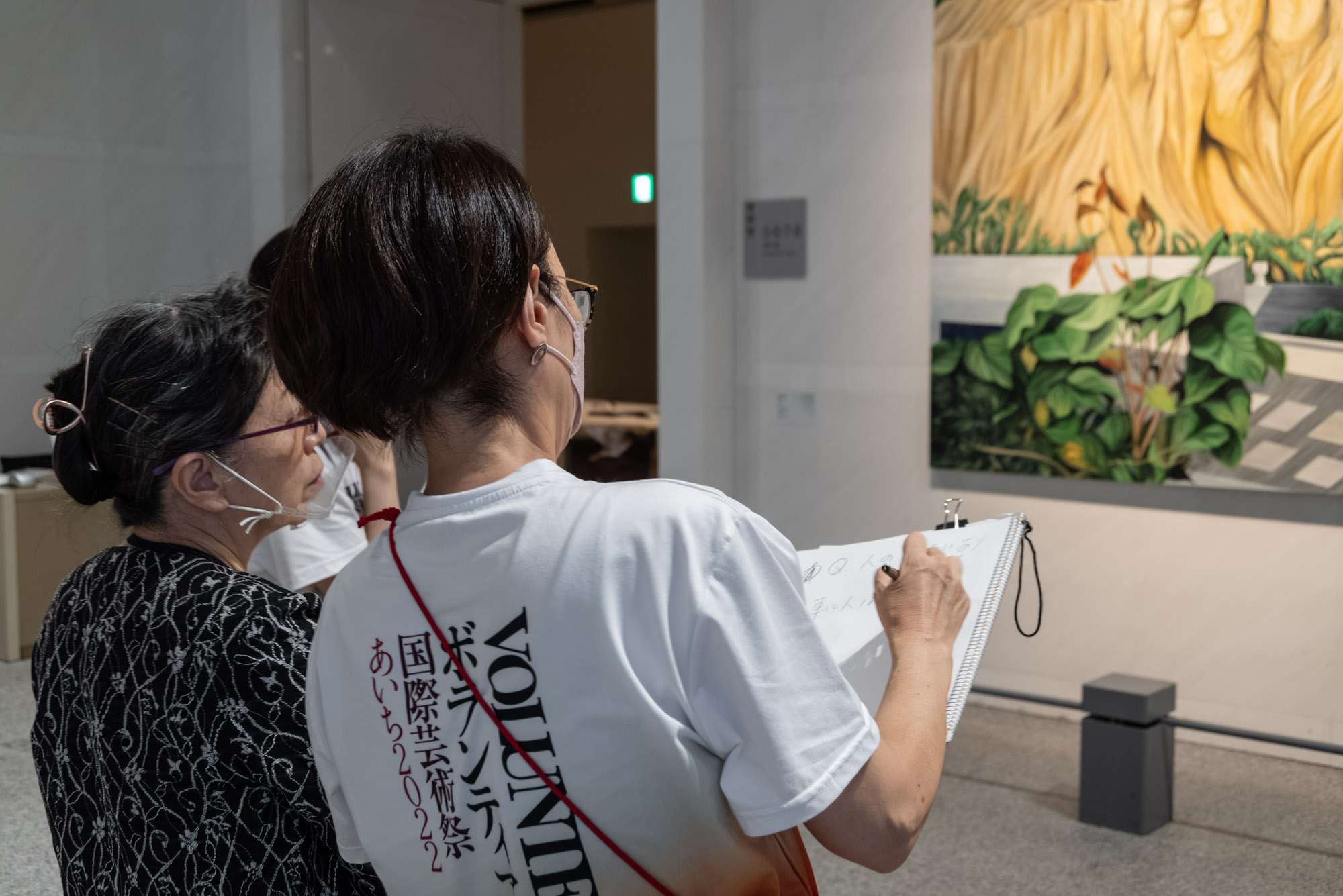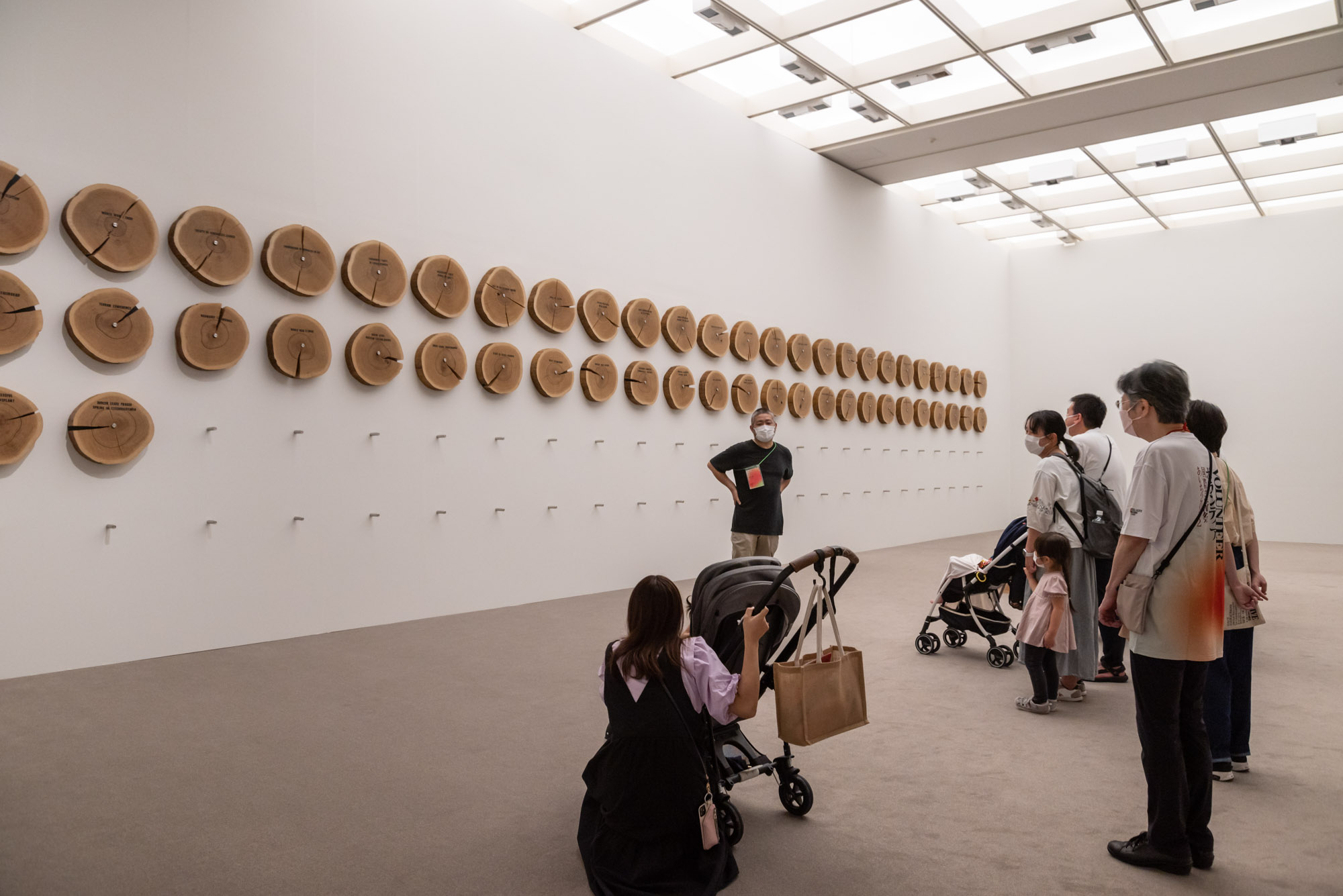LEARNING
Guided Tours:
With the help of the guideʼs commentary and interactive viewing of the exhibits, visitors were able to broaden and deepen their insights, understanding, and overall viewing experience. Curators and volunteers guided visitors through the Aichi Triennale 2022, according to individual needs, including tours for those speaking languages other than Japanese or for persons who had visual or hearing impairments.
- Guided Tour by Volunteers
- Tour for the Visually Impaired
- Tour for non-Japanese speakers
- Written Communication Tour
- Baby Stroller Tour
- Reflecting on the Guided Tours
- Guided Tour by Volunteers
-
Tours by volunteering guides every weekend and holidays at each site (on Fridays too at the Aichi Arts Center). The volunteer tour guides chose 1 to 4 works of art to create their own concept for the tours.
Each tour was limited to 15 visitors per tour and in the end, we had 1513 people visit the tours.
Photo: ToLoLo studio
- Tour for the Visually Impaired
-
Tours presented orally for the visually handicapped. The volunteers decided and created the concept of the tour and divided themselves into several roles which were explainers of the artwork, the main progressor, supporters for the whole group and helpers for the visitors. In the 2 days of the tour, there were 21 people including the helpers who visited the events.
※Cooperation by Nagoya Lighthouse Information & Culture Center

Photo: ToLoLo studio
- Tour for non-Japanese speakers
-
Tours for non-Japanese speakers in English, Spanish and French. For these tours, groups were made for each language and the volunteers decided on 1 to 3 artworks to create their own concept of the tour. There were 30 people who visited the events in the 3 days.

Photo: ToLoLo studio
- Written Communication Tour
-
Tours presented using a written communication.
For the tours, we divided into small groups with one main progressor and the remaining volunteers who used written communication one on one to look at the art with the visitors. After the tour, the group got together to share what each had talked about to improve the communication for the next tour.
In the two days, there were 12 people who visited the events.※Cooperation by NPO Aichi Association of Hard of Hearing and Late-Deafened People

Photo: ToLoLo studio
- Baby Stroller Tour
-
Tours for parents with young children to be able to enjoy the art festival comfortably with the help of curators from Aichi Triennale 2022. The curators did explanations of the artwork by looking carefully at the children’s reactions. In the 3 days, there were 11 groups or 37 people who visited the events.

Photo: ToLoLo studio
Reflecting on the Guided Tours
Nakamura Fumiko, a curator of contemporary art at the Aichi Prefectural Museum of Art, and two curators of the Learning Programs looked back on the guided tours they conducted and discussed the role of guided tours in arts festivals and the ideal practice of art appreciation.
Date | December 12 (Fri), 2022
Format | Online
Speakers |
Nakamura Fumiko (Curator of Aichi Triennale 2022 [contemporary art], Senior Curator of Aichi Prefectural Museum of Art)
Yamamoto Takayuki (Curator of Aichi Triennale 2022 [Learning], Artist)
Aida Daiya (Curator of Aichi Triennale 2022 [Learning], Museum Educator)
- Aida:
- Ms. Nakamura, you work at the Aichi Prefectural Museum of Art. What types of tours do you offer there?
- Nakamura:
- In terms of an art viewing tour, we offer one for groups of 20 or more1. Aside from that, we provide viewing programs for children and people with visual impairment, depending on the exhibition.
- Aida:
- Do you see any difference between the tours you offer at your museum and those we conducted during the Triennale?
- Nakamura:
- At our museum, I have the impression that the largest number of requests come from schools, followed by travel agencies that offer tours that visit multiple museums. On the other hand, at the Triennale, tour participants often meet each other for the first and only time. In that sense, members can be more diverse. Additionally, those who join tours at the arts festival are generally eager to learn new things, so I find it easier to work with them.
- Yamamoto:
- A tour is a unique form of art appreciation. There are tours where you view artwork with predetermined values, while those at arts festivals include works with undetermined values (indeed, encountering such works is one of the best aspects of art appreciation). From that perspective, what were you particularly conscious of when conducting our tour series?
- Nakamura:
- During the Triennale, I mainly conducted tours for professionals and officials. In tours for art-related professionals, it was relatively easy to communicate with the participants because we shared a background understanding and the language of art. However, when guiding those who don’t necessarily specialize in art, such as local government officials, we had no common basis, like art vocabulary, to begin with. When that happened, I consciously avoided using art as the subject and focused more on social issues the works were tackling, like those of refugees, the environment, and hikikomori [social reclusion or social recluses], which captured their interest.
- Aida:
- Social issues become the common language, not art. Interesting.
- Nakamura:
- That’s right. I also found that works with clear rules were easy to explain and got the viewers excited, but the sensuous pieces were harder to deal with.
- Yamamoto:
- The truth is that even those sensuous works address social issues and problems in some ways because they are expressions by artists who live in the same era and society as ours. In fact, “contemporary art” is closer to us than pre-modern art. That is why I aimed to offer Learning Programs at the Aichi Triennale 2022 that provided various forms of encounters with art and guided the participants toward experiences that would help them gain new perspectives on the world.
- Nakamura:
- I agree. If it was simply about social issues, we could just read newspaper articles or watch TV news.
- Aida:
- We see more and more artworks dealing with social topics. I think artistic expressions are unique because they confront issues from more personal perspectives different from one-sided moral standards.
- Nakamura:
- I was impressed by Watanabe Atsushi’s project, which originated from his own experience of hikikomori. The subject matter is often overly simplified and reduced to remarks like “hikikomori is not good” or “loneliness is bad, so let’s connect with others.” But that was not what he was aiming for. Instead, his work could be read as a message saying, “it’s OK to be a social recluse” and “even if you remain lonely, you can find a place for yourself in the world.” A guided tour allows me to convey such subtleties and nuances that conventional major media cannot.
- Yamamoto:
- We all live in today’s society simultaneously, but Watanabe’s work presents his own perspective. That’s one of the highlights of appreciating contemporary art. The work also functions as a platform for discussing social issues. His perspective is not a conclusion or an answer but rather what he felt or thought and suggests how a viewer can approach the problems.
Either way, I hope that art that goes beyond just presenting relative values, like a win/lose or profit/loss, will prevail more. To judge something based on winning or losing is valid when the world is stable, but in a time of change, what constitutes a win or gain becomes ambiguous. I believe art nurtures the power needed to survive such a world. - Aida:
- Listening to your conversation, it occurred to me that the great thing about a guided tour is that the viewers can make personal responses to artists’ personal expressions.
- Nakamura:
- Another initiative of the arts festival I really liked were the non-English, multilingual tours. The fact that the Triennale decided to offer them even though the number of overseas visitors was limited due to immigration restrictions during the pandemic speaks to its determination to reach the locals whose native language is not Japanese.
Throughout Japan, people often boost global dissemination of information, but they tend to only have a vague idea of inviting cultural figures from overseas or a faint hope that foreigners would be interested in Japanese content. On the contrary, Aichi Prefecture has the second largest number of residents with foreign citizenship in Japan. - Aida:
- I was surprised to learn that the number of people with overseas roots living in Aichi amounts to 3% of the prefecture’s total population.
- Nakamura:
- I think approaching those who live close by but don’t use Japanese as their native tongue is one of the essential ways of global communication.
- Aida:
- Specifically, we were able to offer tours in Spanish and French, in addition to English. Ideally, we want to provide many more languages.
- Nakamura:
- I completely agree. If we look at the population ratio, there should be more Chinese, Korean, and Portuguese speakers. I think the fact that there are not enough volunteer guides proficient in these languages reveals, in a way, the current situation.
We also got a realistic idea for implementation from a volunteer, which was to conduct tours in simple Japanese and English. I imagine there are occasions when you cannot explain everything perfectly in Portuguese, but you can communicate basic information in Japanese and simple English. On the other hand, artworks’ descriptive texts cannot be fully understood without decent language and reading skills because they are often academic and loaded with information in a small number of characters. It’s the same for Japanese or English.
But sometimes, that level of skill is not needed. For example, you can describe the piece by On Kawara by saying, “He sends telegrams for 30 years. Here are the telegrams he sent to many places in the world. All have the same words ‘I AM STILL ALIVE’.” - Aida:
- What you just said is very thought-provoking. It’s about more than just a language. It’s about your will to communicate and fundamental attitude of putting yourself in the other person’s shoes.
- Nakamura:
- Suppose the goal was to spend time together in the same space. In that case, I think there would be people willing to enjoy the exhibition and the art viewing experience using broken English and simple Japanese.
- Yamamoto:
- What we need to do as a learning program for an arts festival is not to bring in someone with good language skills. We need to create a place, like art, where various people can participate in different ways.
- Nakamura:
- I also have a question. In an interactive viewing program, there is a theory that suggests not imposing a particular perspective on the viewers or giving them prepared information from the beginning. However, they may have comments or opinions that clearly differ from what I intend to convey. For example, if a viewer “pities” a minority artist, I don’t want it to be their only response. I would like to know how best to communicate that point.
- Aida:
- For example, if someone sees Watanabe’s work that we discussed earlier and comes to the conclusion that “it is not good to be a social recluse,” I think that should be respected as an opinion. The priority in interactive viewing is to create a state in which the viewer’s brain is continuously engaged in the artwork. If, as a result, a person concludes that “being a social recluse is not good,” then we consider it merely a revelation that the person has been firmly imprinted with such a viewpoint.
We can also present information. When showing Watanabe’s work, for example, providing a story like, “For those who have experienced being hikikomori or had difficulty engaging in social activities, the work could offer a means to empathize,” is an actual pattern we follow to present a different point of view. - Yamamoto:
- A certain number of people want to be left alone when viewing art, so there should be an alternative way to encounter artwork that is not a guided tour. I think it is a must, and it can develop further to create more demand. It is perfectly acceptable that there are many ways to encounter and appreciate art; it is better if there are different means. In this respect, we must continue to think about how to operate interactive viewing.
- Nakamura:
- I’m going off-topic a bit, but I was at the Ryukoku Museum in Kyoto for a special exhibition introducing the history of museums and exhibitions in Japan. One of the exhibits showed that, in the Meiji era, there were signs prohibiting preaching at an exhibition of sacred treasures from temples. I imagine some knowledgeable viewers initiated “interactive viewing,” without permission, in front of a calligraphic work by a great monk or a Buddhist painting, saying, “The work is by such and such and says this and that.” That’s why Japanese museums and exhibitions have disallowed preaching since the very beginning. In other words, they established a rule that forbade talking in front of exhibits.
- Yamamoto:
- That’s super interesting.
- Aida:
- What you’re saying is that the viewers also have an accumulation of information about the artwork, and the artwork functions as a trigger to draw the information out of them.
- Nakamura:
- But, as Yamamoto mentioned earlier, there are two types of people: those who can engage in a discussion immediately and on the spot; and those who have a lot of thoughts and feelings in their heads but are unable to express them to an outsider. The latter probably write their reviews on social media. What kind of platforms can an exhibition organizer provide for them to share their ideas? The Triennale’s Learning Program included a section (Intermission Talk) where everyone’s comments were posted. It was a phenomenal method, but I think it was the best and most straightforward way.
- Aida:
- The Intermission Talk was structured so that the conversation was prompted by inquiries to others, rather than simply listing one’s own opinions, and one gave an answer only in response to a question. I also think the tour format can be diversified, like a tour with a museum guard.
- Yamamoto:
- You mean, the guard becomes the tour guide, right? Different from that, but we were planning a tour for all the people who work at the Arts Center, not only the curators and clerks, but also the cleaners, security guards, etc.
- Nakamura:
- Maybe we can do a “tour to see only the works weighing 100 kg or more.” We’ll be asked, “How did you carry them?” “How did you secure the route?” (laughs). Something like that would be fun, too.
- Yamamoto:
- Let’s start with what we can do and move step by step.
- Nakamura:
- Definitely. I was also thinking we could do this and that.
- Aida:
- Ideas keep pouring out!
(Text by Kondo Reiko)


![STILL ALIVE Aichi Triennale 2022, July 30 (Saturday) to October 10 (Monday, public holiday), 2022 [73 days]](/2022/en/img/title-logo-date-en.svg)
